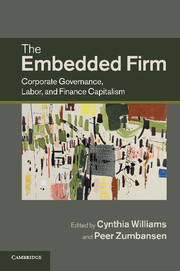Book contents
- Frontmatter
- Contents
- Figures
- Tables
- Contributors
- 1 Introduction: corporate governance after the ‘end of history’
- Part I Historical trajectories of business and regulation
- Part II New interests, new shareholder constellations, new landscapes
- 8 Beyond the Berle and Means paradigm
- 9 Pension funds as owners and as financial intermediaries
- 10 Credit derivatives market design
- 11 The EU Takeovers Directive: a shareholder or stakeholder model?
- 12 “Law and finance”
- Part III Labor’s evolution in the new economy
- Part IV The transnational embedded firm and the financial crisis
- Part V Conclusion
- Index
- References
8 - Beyond the Berle and Means paradigm
private equity and the new capitalist order
from Part II - New interests, new shareholder constellations, new landscapes
Published online by Cambridge University Press: 07 September 2011
- Frontmatter
- Contents
- Figures
- Tables
- Contributors
- 1 Introduction: corporate governance after the ‘end of history’
- Part I Historical trajectories of business and regulation
- Part II New interests, new shareholder constellations, new landscapes
- 8 Beyond the Berle and Means paradigm
- 9 Pension funds as owners and as financial intermediaries
- 10 Credit derivatives market design
- 11 The EU Takeovers Directive: a shareholder or stakeholder model?
- 12 “Law and finance”
- Part III Labor’s evolution in the new economy
- Part IV The transnational embedded firm and the financial crisis
- Part V Conclusion
- Index
- References
Summary
Introduction
The collapse of the credit markets that began to roil the global financial system in the late summer of 2007 hit more than just the homebuilding and mortgage sectors of the economy. As interest rates increased, private equity, or “PE,” an important new form of financial capital, also felt the shockwave. PE funds have grown substantially in size as well as in political and financial significance in the last decade. The Blackstone Group, for example, one of a handful of top tier PE funds, took over the Hilton Hotels Corporation for $26 billion in 2007. Cerberus Capital, another major PE player, surprised many when it announced plans to buy the troubled Chrysler Group from DaimlerChrysler – a pioneering venture into the top ranks of industrial United States.
KKR, one of the oldest PE funds, currently owns such a large number of independent businesses that it is, indirectly, the second largest employer in the United States with 560,000 employees, twice as many as GM, ahead of MacDonald’s and just behind Wal-Mart. Today’s PE fund managers have been hailed widely in the business press as the new “masters of the universe,” pushing aside bond traders and investment bankers, not to mention lowly CEOs. The managers of the largest funds are billionaires. Henry Kravis, the second “K” in KKR, has a wing named after him at New York’s Metropolitan Museum of Art.
- Type
- Chapter
- Information
- The Embedded FirmCorporate Governance, Labor, and Finance Capitalism, pp. 151 - 176Publisher: Cambridge University PressPrint publication year: 2011
References
- 2
- Cited by



